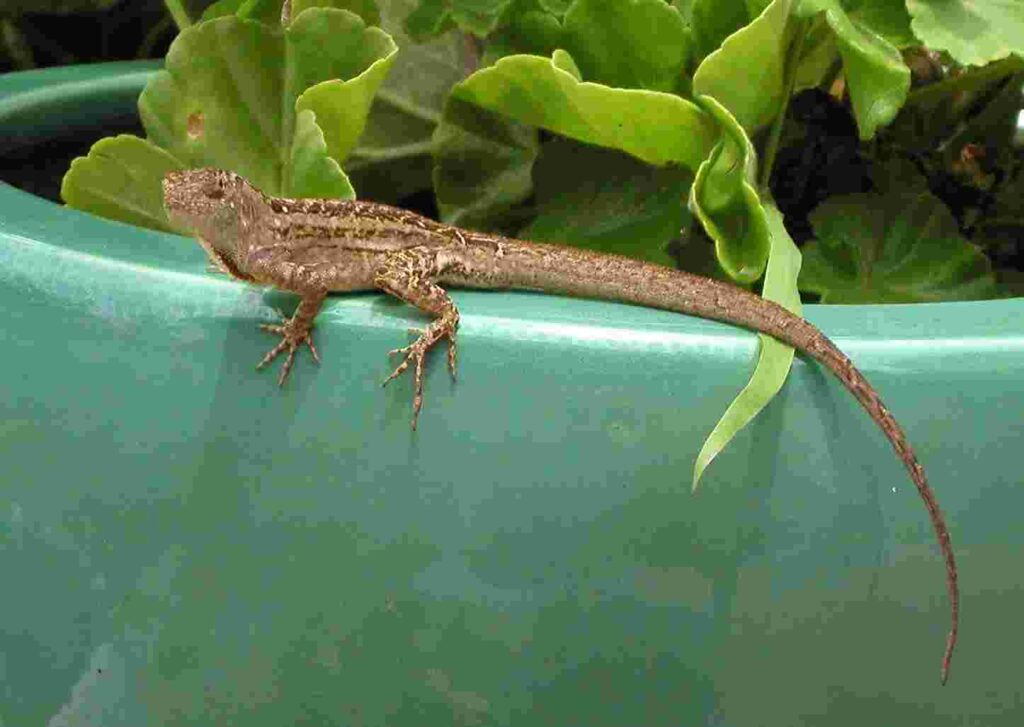
Pat Foster Turley
September 16, 2021
Many of you living here in Nassau County are very familiar with at least two species of backyard lizards, both anoles. The green anole is a longtime native to North Florida, widely admired for its ability to turn various shades of green and brown depending on its mood or background coloration. Some people here call them chameleons, although real chameleons are only found in Africa, Asia and southern Europe. Our other now-common anole is always brown, with more distinct markings and is called the Cuban anole for the general origin of these lizards that moved north to our area a few decades ago.
When Cuban anoles first were seen in our area they were thought to out-compete our native green anoles, with a fear of wiping them out. But now, as far as I can tell, both species have adapted to coexist, with the green anoles often claiming higher leafy areas, while the Cuban anoles seem to prefer areas closer to the ground.
The Florida Keys are now facing their own influx of invading lizards, and the outcome is still undetermined. One thing that is sure, is the increasing presence of large green iguanas throughout south Florida and into the Keys, which probably originated in a fruit shipment from Latin America. On our recent trip to the Keys we enjoyed watching a couple of green iguanas every day that roamed an area near our hotel, but I also wondered about the laws regarding these invasive reptiles. Like any alien invasive species they no doubt compete with other animals for habitat and resources, but more than this they eat up people’s gardens, leave large droppings around and are considered by many to be an outright nuisance.

The Florida Fish and Wildlife Commission (FWC) has taken a strong stance on iguana removal in Florida. Home owners are encouraged to kill any they find in their area, and trappers are also permitted to remove them. In Central and South America, where these lizards are native, there are many recipes for cooking these “chickens of the trees” that, proponents say, actually do taste like chicken. A quick Google search will yield lots of recipes. People with pet iguanas are encouraged to microchip them, and to keep them inside. Those roaming outside, where the iguanas like to be, are open for capture, and, if no microchip is found, they will be exterminated and maybe even consumed. I sure hope the two green iguanas I became familiar with in the Keys are microchipped!
In the Keys I also noticed another species of lizard that was unfamiliar to me. I haven’t been to the Keys in maybe ten years and this lizard arrived here since then. Apparently, this lizard was imported from the Caribbean in the 1940s by sugar cane producers seeking pest control for their crops. Since then, these invasive reptiles have consumed many native lizards like green anoles and taken over much of the habitat. Apparently, they are voracious eaters and will eat almost anything from other lizards to insects, plants, and even garbage, giving them a reproductive advantage over our native lizard species.
We had a small gecko living with us in our hotel room in the Keys too. This is another non-native reptile species, but so far has not garnered strict attention from FWC. Most of them stay out of sight and some only live indoors where they consume cockroaches and other bugs that are themselves consider to be pests by homeowners. The gecko we lived with only appeared at night, and it was so small that we feared stepping on it and killing it. We didn’t want to do that. I thought about putting it outside but I’m sure glad I didn’t.

Besides the local green iguanas, the hotel also had an outside population of curly tailed lizards right outside our room door. Had I gently put our treasured gecko friend outside, I now know that he would have been quickly consumed. Phew, disaster averted, at least by us, this time.
Florida has a great climate for lizards from many places in the world, and species from elsewhere are increasingly getting introduced through fruit and plant shipments and released pets. And, unlike the Cuban anoles that now seem to have found an unoccupied niche, others are becoming a real problem. Keep your eye out in your back yard for tegus, large reptiles now found in South Georgia. They may be here next!
Pat Foster-Turley is a zoologist on Amelia Island. She welcomes your nature questions and observations. [email protected]

Thanks for the great info on invasive reptiles, Pat. I would say the Cuban anole has taken over much of the green anole’s niche; I see far fewer of the latter than I used to. I’ll have to spend more time looking up into the trees to find them, I guess.
Info on the tegu: https://georgiawildlife.com/tegus
Pat,
Thoroughly enjoy all your columns, but this, in particular, with photos to help in identification. The photos help us “lay” people to become more educated.
Thank you.
Although I grew up in the Virgin Islands, I had never seen a Curly Tailed lizard until I visited the Abacos as an adult. Other than their distinctive tail and relatively large size, the thing that struck me the most was that the local cats seem disinterested in messing with them.